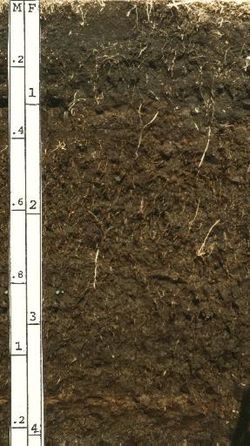Histosol
| Histosol | |
|---|---|
 A Histosol profile | |
| Used in | WRB, USDA soil taxonomy, other |
| WRB code | HS |
| Profile | OC |
| Parent material | Organic matter |
| Climate | subarctic, other |
In both the
Organic soil material has an organic carbon content (by
, which are saturated by rainwater and lack connection to nutrient-containing groundwater.Histosols are known by various other names in other countries, such as
Histosols form whenever organic matter forms at a more rapid rate than it is destroyed. This occurs because of restricted
Most Histosols occur in Canada, Scandinavia, the West Siberian Plain, Sumatra, Borneo and New Guinea. Smaller areas are found in other parts of Europe, the Russian Far East (chiefly in Khabarovsk Krai and Amur Oblast), Florida and other areas of permanent swampland. Fossil Histosols are known from the earliest extensive land vegetation in the Devonian.
Histosols are generally very difficult to cultivate because of the poor drainage and often low chemical
Like
In USDA soil taxonomy, Histosols are subdivided into:
- Folists – Histosols that are not saturated with water for long periods of time during the year.
- Fibrists – Histosols that are primarily made up of only slightly decomposed organic materials, often called peat.
- Hemists – Histosols that are primarily made up of moderately decomposed organic materials.
- Saprists – Histosols that are primarily made up of highly decomposed organic materials, often called muck.
- Wassists - Histosols that have a field observable water table 2 cm or more above the soil surface for more than 21 hours of each day in all years.
See also
- Acid sulfate soil
- Hydric soil
- Pedogenesis
- Pedology (soil study)
- Soil classification
- Soil type
References
- ^ IUSS Working Group WRB (2022). "World Reference Base for Soil Resources, fourth edition" (PDF). International Union of Soil Sciences, Vienna.
- ^ Soil Survey Staff (2022). "Keys to Soil Taxonomy 13th edition" (PDF). USDA Natural Resources Conservation Service.
- ^ "Hydric Soils of Florida". Wetland Evaluation and Delineation Program. Florida Department of Environmental Protection.
- ^ "Australian Soil Classification – Organosols". CSIRO. Retrieved 8 February 2016.
- "Histosols". USDA-NRCS. Archived from the original on 2006-05-09. Retrieved 2006-05-14.
- "Histosols". University of Idaho. Archived from the original on 2006-09-01. Retrieved 2006-05-14.
Further reading
- W. Zech, P. Schad, G. Hintermaier-Erhard: Soils of the World. Springer, Berlin 2022, Chapter 3.3.1. ISBN 978-3-540-30460-9
External links
- profile photos (with classification) WRB homepage
- profile photos (with classification) IUSS World of Soils
